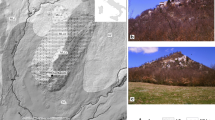Abstract
A description of the superficial and underground constructions as well as the existing structural problems of St. George castle of Cephalonia is attempted, in order to organise a restoration plant of the site.
The area of study is sited 5km SE of the major twon of the island of Cephalonia, Argostoli.
During the field investigation, a total of 565 discontinuity measurements, at seven narrow sampling areas, were taken. Using the Schmidt-diagram method through data processing, it was concluded that the rock mass behaves like a compact mass and does not generate any stability problems to the castle construction.
It is noticeable that the structural problems of the castle buildings are due mainly to the earthquake activity of the area, followed by unfavourable climatic conditions and human intervention.
The study of the materials used in each phase of construction, as well as the determination of their provenance, have been proved very useful in case of restoration of the castle.
Résumé
On a étudié les constructions superficielles et souterraines et aussi les conditions géologiques, structurales et géotechniques de la zone de fondation de la forteresse St. George de Cephalonie, située à 5 km SE d'Argostroli, en vue de sa restauration.
On a constaté que la zone de fondation des calcaires du Crétacé ne pose pas de problèmes de stabilité et pourtant il y a de sérieuses déformations et catastrophes, qui sont provoquées surtout par les tremblements de terre, drès fréquents dans les îles Ioniennes. Les conditions climatiques (humidité élevée et pluviométrie forte: ≊ 1200 mm) la proximité de la mer et même les activités humaines et des interventions inopportunes (plantation d'arbres) sont aussi responsables de différentes altérations et déformations.
L'étude des matériaux de construction (calcaires et calcarenites) et la localisation des anciennes carrières donnent la possibilité d'utiliser les mêmes pierres pour la restauration de la forteresse.
Similar content being viewed by others
References
B.P. Co LTD, (1967): Geological map of Cephalonia and Ithaki, scale 1: 100.000.
GERTING H., (1972): Focal mechanism and tectonics in the area of the Ionian islands Kefallinia and Zakynthos. Bull. Geol. Sco. Gr. Vol. X 1 (1973).
HODGSON J.H. and COCK J.I., (1957): Direction of faulting in the Greek Earthquakes of August 9–13, 1953. Ann. Géol. d.P. Hell., T. 8, pp. 29–47.
IGME. Geological map of Cephalonia, scale 1:50000.
KOSMETATOS N.F., (1966): St. George Castle of Cepfalonia. The old capital of the island. Athens. (in Greek).
KOUMANTAKIS I. et ORFANOUDAKIS A. (1988): Etude des calcarenites dans lesquelles sont creuses des tombeaux de la période mycenienne tardive a Mazarakata et Metaxata de Cephalonie (Grece). Proc. Intern. Symp. “The Eng. Geol. of Ancient Works, Momum., Histor. Sites”. Athens 1988.
LATOUSSAKIS J., DRAKOPOULOS J., (1985): Proposal for a modification of the cumulative Frequency-Magnitude Relationship. Proc. of the 23rd Assembly of IASPI, Tokyo (Abstracts).
LATOUSSAKIS J., DRAKOPOULOS, (1985): Reoccurence formulas for the largest earthquake magnitude based on the modified cumulative frequency magnitude relationship. Proc. of the 23rd Assembly of IASPI, Tokyo (Abstracts).
LE PICHON X. and ANGELIER J., (1979): The Hellenic Arc and trench system: a key to the neotectonic evolution of the Mediterranean area. Tectonophysics 60, pp. 1–42.
MAKROPOULOUS K., DRAKOPULOS J., KATOUSSAKIS J., (1986): A revised earthquake catalogue for Greece since 1900. Univ. of Athens, seism. lab. publ. No. 2, p. 132.
Mc KENZIE D., (1972): Active tectonics of the Mediterranean region. Geophys. J.R. Astron. Soc. 30, pp. 109–185.
MERCIER J., BOUSQEUT B., DELIBASSIS N., DRAKOPOULOS I., KERAUDREN B., LEMEILLE F. et SOREL D., (1972): Déformations en compression dans le Quaternaire des rivages ionniens (Cephalonie, Grece). Données néotectoniques et sismiques. Bull. Soc. Géol. Gr. v. X, 1, 1973.
SCHMOLIN J., (1981): Some results about the sedimentology of Pliocene on the Ionian islands Kephallinia and Zakynthos (Greece). Rapp. Comm. Int. Mer Medit., 27, pp. 87–89.
SOREL D., (1976): Etude néotectonique dans l'arc Egeen externe occidental. Les iles Ioniennes de Kephallinia et Zakinthos et l'elide occidentale. Theses Univ. de Paris XI.
ULICZNY F. (1969): Hemicytheridae und Trachyleerididae (ostracoda) aus dem Pliozän der Inseln Kephallinia (Westgrichenland). Diss. Univ. Munchen, 152s.
UNDREHILL J.R. (1985): Neogene and quaternary tectonics and sendimentation in western Greece. Thesis Univ. of Wales.
Author information
Authors and Affiliations
Rights and permissions
About this article
Cite this article
Kolaiti, E., Koumantakis, J. Engineering-Geolocial study of St. George castle of Cephalonia (Ionian Islands, Greece). Bulletin of the International Association of Engineering Geology 43, 61–67 (1991). https://doi.org/10.1007/BF02590171
Issue Date:
DOI: https://doi.org/10.1007/BF02590171




